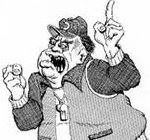sans serif
A typeface that does not have a serif (crossline) decorating the main strokes of the characters.
sentence style
Capitalization style for heads and titles in which all words are in lowercase except those that would be capitalized in a sentence. Also called initial cap only.
serial comma
Comma preceding and or or in a list of items (one, two, and
serif
A decorative line crossing the main strokes of a letter in some type styles such as Times Roman.
sidebar
A short article or news story that complements or amplifies a major article or story.
signposting
Cross-references to topics previously discussed in a document.
sink
Distance from the top of a printed page to a specific element on that page.
solidus
Name of the / character. Also called slash or virgule.
specs
Type specifications indicating typeface, point size, spacing, margins, and the like.
stet
Latin for "let it stand." Indicates that text marked for deletion should be restored.
style sheet
Form filled in by a copy editor as a record of editorial decisions applied to a manuscript.
subhead
Small headline in the body of a text.
T of C
Short for table of contents. Also called TOC.
TK
Short for to come. Refers to material not yet in place.
trade books
Books meant for general readers, as distinguished from books intended for professionals, scholars, or students.
trim
To reduce the length of a story. Also called boil.
trim size
Dimensions of a page of a book.
UC
Short for uppercase (capital letters).
UC/lc
Short for uppercase and lowercase. Indicates that text is to be capitalized according to headline style.
unnumbered list
Vertical list in which items are not marked by either numbers or bullets.
widow
The last line of a paragraph that appears alone at the top of a page. Sometimes also refers to an orphan.
Short for cross-reference.







No comments:
Post a Comment